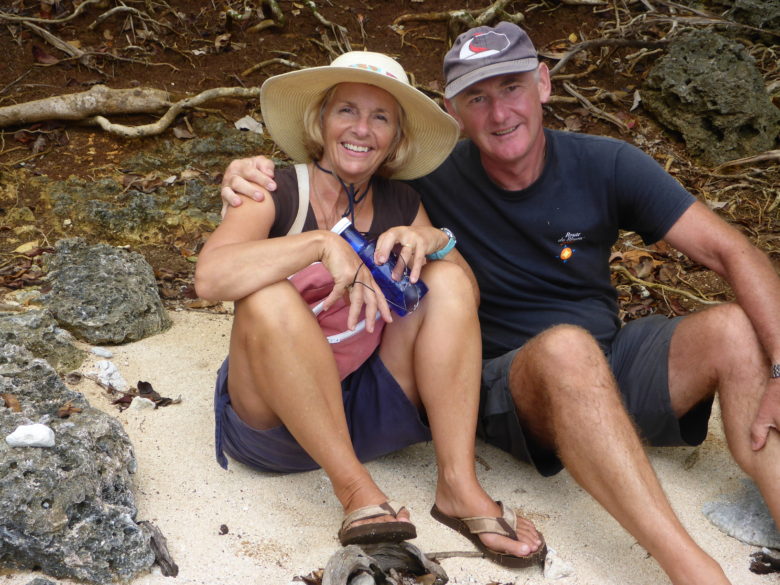Hunga Haven and a truly remarkable day.
As we came in the day before yesterday we followed another yacht and watched her progress using the AIS on our tablet. Her name is Sonrisa, a Catalina 40 built in 1980 and she is registered in Las Vegas, maybe because sailing is, at the best of times, a bit of a gamble. We had a lovely evening with Andrew and Lesley on board yesterday but let me start at the beginning.
I am a nosey parker, I know I am, I can’t help it and sometimes the trait has its uses. I was standing in the saloon first thing yesterday having just committed the blog to the computer, reading the Betty Crocker cake mix box and thinking of course her cakes are ‘Always Moist’, as the box said, there’s half a cup of oil in them! When I heard Barry’s powerful outboard motor whizzing across the lagoon. He appeared to have a few people on board and they were making rapid progress, then suddenly they stopped. Folk started leaning over the stern and then I noticed they tilted the motor forward so the prop was out of the water. Then heads started turning towards us and their home behind on the shore. One person stood in the boat and gave the classic alarm signal of waving arms.
I clicked on VHF Channel 26 and called up Cindy. We went down to Channel 13 and I told her what I had just seen. Our outboard motor was still clinging to the pushpit rail so I explained we would be able to give them a tow in a few minutes, but by the time we were ready Andrew was already off in his folding dinghy. First he delivered Barry’s guests to another beach and then returned to the stricken metal boat and by the time we were making our way to them he had Barry and Clement in the boat moving along behind him at a good speed.
We rowed ashore later to do some hiking and while chatting to Barry who seemed to think the culprit was the gearbox that had suddenly shed its oil, we offered him the use of our dinghy. Slight problem Rob pointed out was that the outboard motor was back on the pushpit on Zoonie. So we rowed back, picked it up and tried again. As the tide was falling and to keep the dinghy afloat Barry tied the painter to his continual line that keeps his boat afloat and retrievable from the shore, and we left him to it.
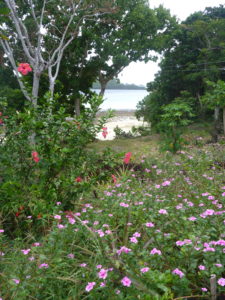
Hunga’s own jungle was part human created and part ancient. We wandered along the narrow man-made path, through the derelict banana plantation around a giant mango tree with piles of split coconuts lying around the base and sensed the past activity of humans eking out a living from fruit and copra production. We were trespassing on their history. The Tongan Crown banishes people from their land if they can get someone to pay for a lease on it and it looked as if that had happened here. The odd item of rotting clothing, the soles of discarded shoes and a tent partially buried in a pit were sinister to behold.
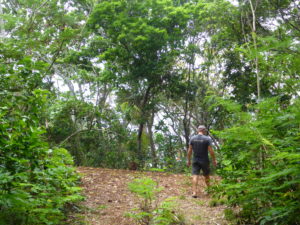
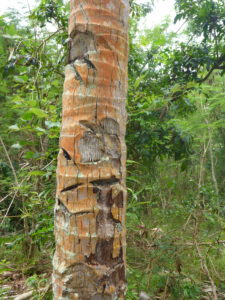
The land rose gently toward the track that led along the ridge of this section of the volcanic caldera. We gathered fallen orange limes but didn’t see any bananas. Rob seemed to think that each palm produces one crop and then dies, maybe that’s why there were none left.
The track was easy walking and we started to hear the waves crashing onto the windward shore as we approached a metal gate that looked more like a bed head. Beside it was a stile of two logs standing on end either side of the wire fence. On the other side was one of the five cows Barry had told us about. The fence was to keep them in, not us out. He also mentioned a bull. “Is it friendly,” I asked.
“Oh I don’t think you’ll have any trouble from him, he has his females with him.” The prospect of no fence between us and a bull gives me the heeby geebies having heard about numerous deaths in the UK caused by people walking across fields with aggressive bulls in them, but I was prepared to give it ago, bulls can’t climb trees.
This little feller when we came across him looked shy and moved away from us, so that was fine, or so I thought. We kept looking around for a dwelling of some sort but all we found was a horizontal branch over which a wet suit, T-shirts, shorts, a pair of floral leggings and a snorkel and mask were dangling. They looked as if they had been there for a while, so why hadn’t someone come back for them? Weird.
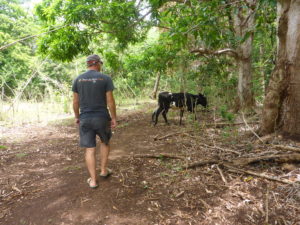
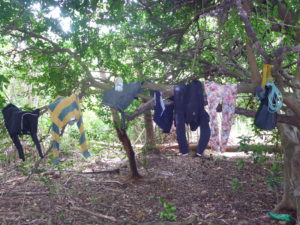
The ocean started to appear through the foliage and we knew we were near the beach but suddenly we saw, huddled together, a few cows and the biggest black and white Holstein bull I have ever seen. “Oh God,” I appealed. Bully looked at us as we walked nonchalantly past, but continued chewing the cud. A brief glance over my shoulder and I saw he was no longer remotely interested.
We walked carefully down a widening red soil track onto the sand and into another world, the world of millions of years ago.
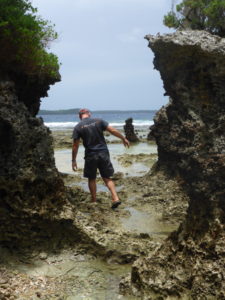
Once upon a time this island had been a high and live volcano, as it died it sank maybe a centimetre a year, not much more. Eventually the rim around the hole at the top of the volcano was at sea level and it filled to form the lagoon. Sea creatures, molluscs, corals and the like grew, thrived and died forming the hard and razor sharp limestone rock that makes up the shoreline today. Some of it has been laid down in sedimentary flats of rock one layer sandwiched on top of another and filled with coral fingers and shells.
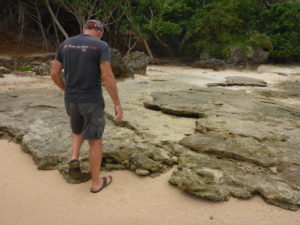
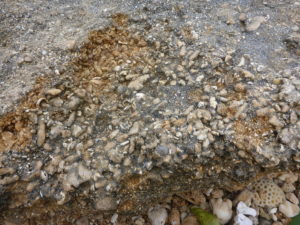
All the rock pools on the shore and in raised up pools in hollows formed from wave action showed activity of some kind. I won’t bore you by mentioning the species that we have seen before which we saw in plenty here, instead we found some new ones.
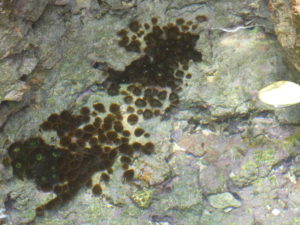
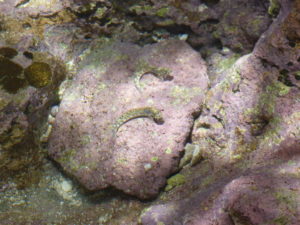
An anemone nursery of tiny ones totally protected from the crashing waves and yet refreshed with seawater on every high tide. Neon tetras, like the ones you would buy at an aquarium in the UK. A live sand dollar that I have only seen before in the Caribbean. A mussel shell at least 8 inches long and big coral growths on ancient pink bi valves. A live ammonite shell, its resident spitting out water and bubbles. Gnarled and contorted trees determinedly clinging onto the water retaining crevices in the limestone rocks.
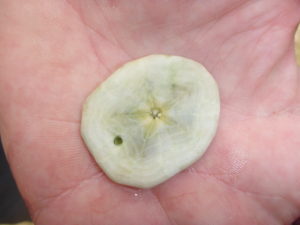
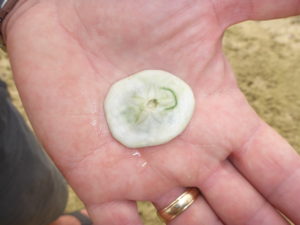
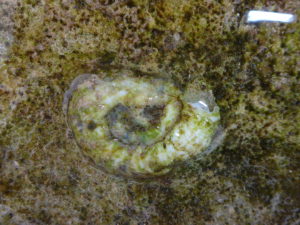
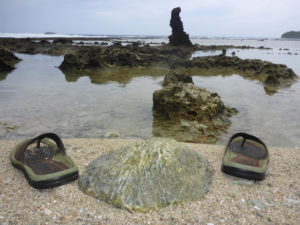
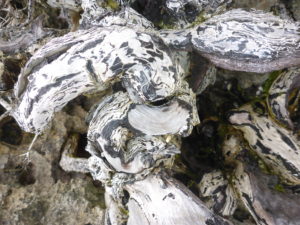
But most extraordinary of all were the Jurassic hovercraft. Chitons. A small colony of these oval shaped mollusc with their overlapping platelets on their backs and a rim just like the skirt of a hovercraft. I recognised them straightaway from my biology studies at school over half a century ago, but I have never before seen one in the shell, let alone a group of five in the wild. And this was a wild place.
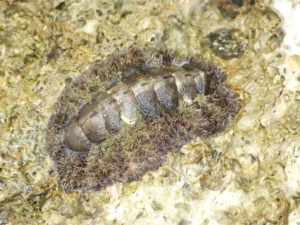
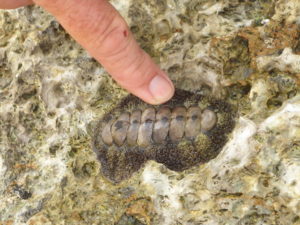
No evidence of man, it was as if we had walked through a jagged limestone time warp and any minute we would hear the roar and feel the vibrating ground as a dinosaur of some kind stomped slathering from the woods onto the beach only to see us running for our lives. This took no imagining, the scene was set all around us.
We didn’t want to leave, we sat and drank our water, posed for a selfy and took our reluctant leave because our tummies were empty and by the time we got back to Barry and Cindy’s house we would be thirsty again.
The dinghy was still away so we did some exploring along the beach opposite Zoonie as it was low tide, before paddling Barry’s orange plastic kayak back to Zoonie and two glasses of welcome water.
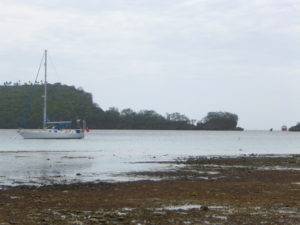

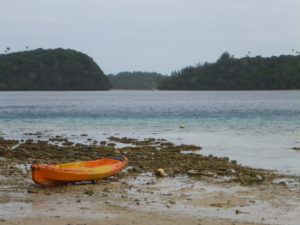
A few minutes later while I was cooking fish, pasta, sliced and fried aubergine and onions with a touch of tomato paste and lime juice, which we demolished quicker than it took me to type this, Barry came alongside and swopped boats. He declined our invitation aboard for a drink as he still had work to do so we were left to finish our meal. Cindy had kindly offered us two hours of free internet on the boat for our morning’s rescue service so Rob set that up while I cleared away.
Then we went to visit Andrew and Lesley on Sonrisa at their invitation and got to know them over the beer we had taken and their rum punch accompanied by Andrew’s corn, freshly popped in coconut oil and warm home-made chocolate brownies. They shone a torch on Zoonie’s hull to guide us home.
Hunga Haven Circumnavigation then onward to North Minerva Reef
Four red New Zealand ensigns rose gently to the breeze on this crystalline blue day. Taking a good look around I was reminded of the idyllic stories of Arthur Ransome in Swallows and Amazons. Hunga even has two wooded islands where one can land a canoe and go exploring. That’s it, the canoe.
We lowered ourselves gently into our now familiar little canoe and started paddling towards one of the islands, or rather the gap between it and the shore. The tide was rising, even so we were aware of the limestone rocks on the reef beneath us so we decided not to land. The little graveyard with its fresh gravel mounds has a promontory all to itself near the small village that straddles a concrete road leading down to the quay.
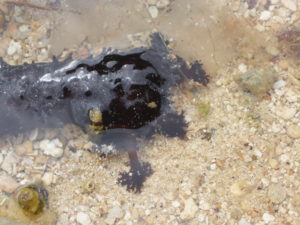
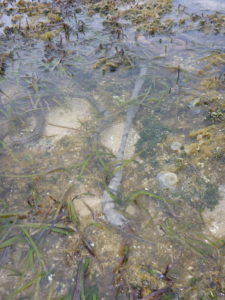
A couple of days before an orange ship had anchored just outside the entrance and little fishing boats from the village went out to wait alongside as plastic water tanks were gingerly lowered onto them. One boat was so tiny it chose to tow them behind and another was loaded with one on the foredeck, another on top and a third over the stern cockpit, the skipper guided by instinct and a sixth sense, back to the quay. They were part of Americanaid and I wondered what price they were expected to pay and what support and votes at a summit maybe.
The quay was quiet as we paddled by towards the clear reef extending out from the shore infront of the now closed resort near where Barry has the use of a holiday home for rental. We kept stilling the paddles to take in the surroundings, the canoe casting a long shadow beneath us startled two green turtles that took off and paddled themselves into the deeper blue water.
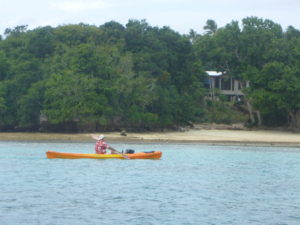
Then a few feet to our right we noticed another bigger regular turtle shape shell, four feet long, and slowly it rose to the surface. Its magnificently patterned shell, shiny from the water, emerged first then its head and hawk like bill, hence the name Hawksbill. He looked at us as we looked back at him, unfussed he exhaled, took in a fresh breath and slowly glided across our bow to join his friends.
There was a substantial jetty we had to deviate around, made of concrete and sand sacks and top layered with smooth concrete, but it had a gap right through it which rendered it pretty useless. We wondered if an earthquake had caused the break and what it was used for in its intact day. There were once coconut and citrus palm plantations working here so I guess the answers in the palm of our hands!
The lagoon has three breaks in the reef only one of which is navigable, the one we came through. The first we came to opened onto the Pacific to the west and sizeable waves broke through causing our little canoe to wobble a bit, but nothing scary. We hovered, watching the swell and white horses outside while we were snuggly tucked inside.
A derelict house, with its own small beach set our imaginations going. It didn’t look like a holiday home with no lagoon facing windows or balcony, so maybe a plantation owner’s home vacated at the same time as the now overgrown plantation. Fruit bats fly gently overhead, but no barking dogs or cockerels here.
Zoonie looked tiny in the distance. We paddled across our entrance, the tin opener rock did look like Marge Simpson with the beaky mouth and beehive hairstyle, just as Rob had suggested. The southern break in the shore looks out over a reef where locals take their little fishing boats day and night and clamber out to collect shellfish and crabs.
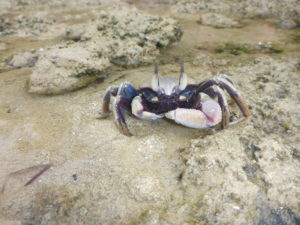
Just a little further to go, a dugout canoe with outrigger awaits its owners return on one beach. I wonder if he was, or knew, the owner of the line of clothes we had found in the woods.
The day was too lovely for sitting around, so with the canoe propped up against the forestay, draining, we went for a snorkel. New on the list was a small lion fish and more of the chubby salmon pink and spindly blue starfish, sand coloured fish with silver eyes and the palest blue small fish floating within the protective spines of an urchin.
Sundowners on that perfect day was spent watching giant fruit bats emerging from one tree, collecting fruit and flying back to another tree, big dark brown shapes in the changing sky, their wingspan had to be a metre at least. The tide was going out on the reef and through binoculars we watched a black heron fishing, crabs on high heels scurrying around and a small white and blue kingfisher, perched on a limestone rock, watching.
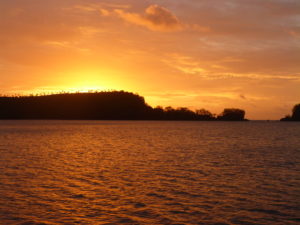
During our stay the little black junk rigged boat called Zebedee was towed in through the narrow gap and picked up one of the buoys next to us, her tow yacht picking up the other. Finally we got to meet Alan and his sailing friend, Caroline. Zebedee is a modern sister ship to Badger, and was built in 2000. Alan is based in New Zealand but Caroline flew out from England for her holiday and lives in Bovey Tracey, not far from my Brother Rob’s farm in Holsworthy, Devon.
Alan gave me his email as we supped tea and ate chocolate cake and I promised to send him all the photos I have taken of her. He is a member of the Junk Rig Association of which I was editor for a number of years when Emily was a little girl and we lived in Lymington.
Barry’s Wi-Fi on board enabled us to catch up with emails, sending blogs and pictures, including the ones to Zebedee, downloading the weather and Googling to our hearts content. So I looked up the Junk Rig Association on Google to find it is fully on line and discovered Annie Hill, one time owner of Badger and whom I met years ago and Alan knows well, is now the president. She lives in New Zealand and is fitting out a new boat, so who knows, maybe our paths will cross once again.
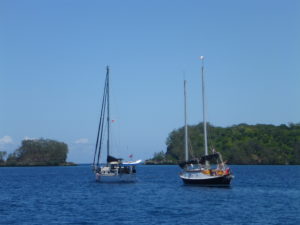
Finally the inevitable day of departure dawned and we rowed ashore feeling excited to be moving on once more, but sorry to be leaving this lovely place.
Clement was busy cutting bathroom tiles, so soon the makeshift shower on the beach, hidden behind a screen of pandanus leaves, will become obsolete. We waited until he saw us and after he turned off the generator had a brief chat before he went to collect Barry, giving us the chance to fuss their lovely black and tan dog, a beach comber and sun bather whose name we never knew.
We settled up, exchanged a few words including the all-important, “May we take four papayas please?” And promised we would be back next year, hoping naively that nothing would have changed to spoil the magical place. Cindy waved from the window as we clambered back into the dinghy, we blew air kisses to eachother.
I spent some time baking for the journey. Cherry crumble, time the tinned cherry pie filling was used with its sell by date Sept 2011. I made too much crumble mix so I added shredded coconut and a beaten egg to the remainder to make biscuits. The flapjack used the last of the golden syrup, the last packet of yoghurt mix was set yogging and the beans I had soaked overnight bubbled away in fresh water along with potato and eggs to hard boil. A couple of tins of tuna added to the beans and potatoes, fried onions and peppers made enough meals for four days.
The following morning was Sunday, a lovely day as we edged back along our black inward route showing on the Raymarine Control App on the tablet. With the early sun low and behind us somehow the gap looked narrower and the water was whirling merrily around the rocks to add a few tense moments with Rob on the foredeck pointing to the safe water.
All clear and off soundings in no time as our distance from the atoll grew we noticed the ultra-modern aerofoil twin masts of a cat we had seen in the Neiafu mooring field. She gradually overhauled us and disappeared off in the same direction as us.
The wind was variable and more south than south east and a slow boat to North Minerva was in prospect. By way of a distraction Rob set the fishing line astern. Not long after there was a squeal from the reel and a loud splash. Something really big judging by the area of bubbles it had created spat out the plastic lure in disgust. Not being one to give up easily Rob reset the line. A few minutes later another squeal and the top of the rod was bent over like a question mark. This time the entire lure and trace went leaving just the line. Soon we saw why.
Not far from Zoonie the biggest tuna we have seen were jumping around us just investigating. I thought they were dolphin to begin with as they were nearly the same size but their body and fin shape were quite different. Charcoal backs and light underbellies with a yellow band along their sides; another one for Mr Google. It was clear the only tuna we would catch would be from the tins in the store cupboard.
